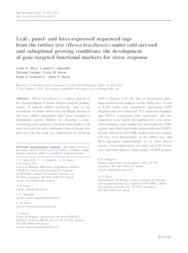Leaf-, panel- and latex-expressed sequenced tags from the rubber tree (Hevea brasiliensis) under cold-stressed and suboptimal growing conditions: the development of gene-targeted Functional markers for stress response.
Leaf-, panel- and latex-expressed sequenced tags from the rubber tree (Hevea brasiliensis) under cold-stressed and suboptimal growing conditions: the development of gene-targeted Functional markers for stress response.
Autoria: SILVA, C. C.; MANTELLO, C. C.; CAMPOS, T. de; SOUZA, L. M.; GONÇALVES, P. S.; SOUZA, A. P.
Resumo: Hevea brasiliensis is a native species of the Amazon Basin of South America and the primary source of natural rubber worldwide. Due to the occurrence of South American Leaf Blight disease in this area, rubber plantations have been extended to suboptimal regions. Rubber tree breeding is time-consuming and expensive, but molecular markers can serve as a tool for early valuation, thus reducing time and costs. In this work, we constructed six different cDNA libraries with the aim of developing gene-targeted molecular markers for the rubber tree. A total of 8,263 reads were assembled, generating 5,025 unigenes that were analyzed; 912 expressed sequence tags (ESTs) represented new transcripts, and two sequences were highly up-regulated by cold stress. These unigenes were scanned for microsatellite (SSR) regions and single nucleotide polymorphisms (SNPs). In total, 169 novel EST-SSR markers were developed; 138 loci were polymorphic in the rubber tree, and 98 % presented transferability to six other Hevea species. Locus duplication was observed in H. brasil-iensis and other species. Additionally, 43 SNP markers in 13 sequences that showed similarity to proteins involved in stress response, latex biosynthesis and developmental processes were characterized. cDNA libraries are a rich source of SSR and SNP markers and enable the identification of new transcripts. The new markers developed here will be a valuable resource for linkage mapping, QTL identification and other studies in the rubber tree and can also be used to evaluate the genetic variability of other Hevea species, which are valuable assets in rubber tree breeding.
Ano de publicação: 2014
Tipo de publicação: Artigo de periódico
Unidade: Embrapa Acre
Palavras-chave: Biblioteca cDNA, CDNA library, Caucho, DNA, Fitomejoramiento, Genetic markers, Hevea brasiliensis, Marcador SNP, Marcador genético, Marcador microssatélite, Marcadores genéticos, Melhoramento genético vegetal, Microsatellite repeats, Plant breeding, Repeticiones de microsatélite, Rubber tree, Seringueira
Observações
1 - Por padrão são exibidas publicações dos últimos 20 anos. Para encontrar publicações mais antigas, configure o filtro ano de publicação, colocando o ano a partir do qual você deseja encontrar publicações. O filtro está na coluna da esquerda na busca acima.
2 - Para ler algumas publicações da Embrapa (apenas as que estão em formato ePub), é necessário ter, no celular ou computador, um desses softwares gratuitos. Sistemas Android: Google Play Livros; IOS: iBooks; Windows e Linux: software Calibre.
Acesse outras publicações
Acesse a Base de Dados da Pesquisa Agropecuária (BDPA) para consultar o acervo completo das bibliotecas da Embrapa.

